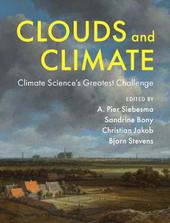
|
Clouds and Climate: Climate Science's Greatest Challenge
Hardback
Main Details
Description
Cloud research is a rapidly developing branch of climate science that's vital to climate modelling. With new observational and simulation technologies our knowledge of clouds and their role in the warming climate is accelerating. This book provides a comprehensive overview of research on clouds and their role in our present and future climate, covering theoretical, observational, and modelling perspectives. Part I discusses clouds from three different perspectives: as particles, light and fluid. Part II describes our capability to model clouds, ranging from theoretical conceptual models to applied parameterised representations. Part III describes the interaction of clouds with the large-scale circulation in the tropics, mid-latitudes, and polar regions. Part IV describes how clouds are perturbed by aerosols, the land-surface, and global warming. Each chapter contains end-of-chapter exercises and further reading sections, making this an ideal resource for advanced students and researchers in climatology, atmospheric science, meteorology, and climate change.
Author Biography
A. Pier Siebesma is a Professor of atmospheric science at the Delft University of Technology and is also affiliated with the Royal Netherlands Meteorological Institute (KNMI) where he has been researching the role of clouds and convection in our climate system since 1990. He pioneered the use of Large Eddy Simulations to design parameterisations for cumulus convection that can be used in numerical weather and climate models. During a consultancy at the European Centre of Medium Range Weather Forecasts (ECMWF), he co-designed the Eddy-Diffusivity Mass-flux (EDMF) approach, to parameterise convective transport by cumulus convection in numerical weather prediction and climate models. He has been the coordinator of the FP7 European Project Euclipse (European Union Cloud Intercomparison, Process Study & Evaluation Project). Sandrine Bony is a Director of Research at CNRS (the French National Center for Scientific Research), working in the Laboratory of Dynamical Meteorology of Sorbonne University, Ecole Normale Superieure, and Ecole Polytechnique. Her research aims at understanding the role of clouds in climate and climate change through the analysis of model simulations, satellite observations and in-situ data from field experiments. She was a lead author of the Fourth Assessment Report of the Intergovernmental Panel on Climate Change and has been coordinating several activities of the World Climate Research Programme (WCRP) related to cloud and climate research. Currently she co-leads (with B. Stevens) the WCRP Grand Challenge on Clouds, Circulation and Climate Sensitivity. Christian Jakob is a professor at the School of Earth, Atmosphere and Environment at Monash University. He is interested in climate models and how scientists around the world can work together to improve them. He has worked for organisations as varied as the United States Department of Energy, the European Centre for Medium-Range Weather Forecasts, and the Australian Bureau of Meteorology. He has led several weather and climate model development activities of the World Meteorological Organization and was a lead author of the chapter on model evaluation for the Fifth Assessment Report of the Intergovernmental Panel on Climate Change. Bjorn Stevens is a director at the Max-Planck-Institute for Meteorology and an honorary professor at the University of Hamburg. His research aims to understand how water in the atmosphere, especially in the form of clouds, shapes climate. He has played a leading role in developing and executing major international field programmes, modelling studies, and scientific assessments related to clouds and climate. He served as a lead-author of Chapter 7, 'Cloud and Aerosols' for the 5th Assessment Report of the Intergovernmental Panel on Climate Change and co-leads (with S. Bony) the World Climate Research Programme (WCRP) Grand Science Challenge on Clouds, Circulation and Climate Sensitivity.
|